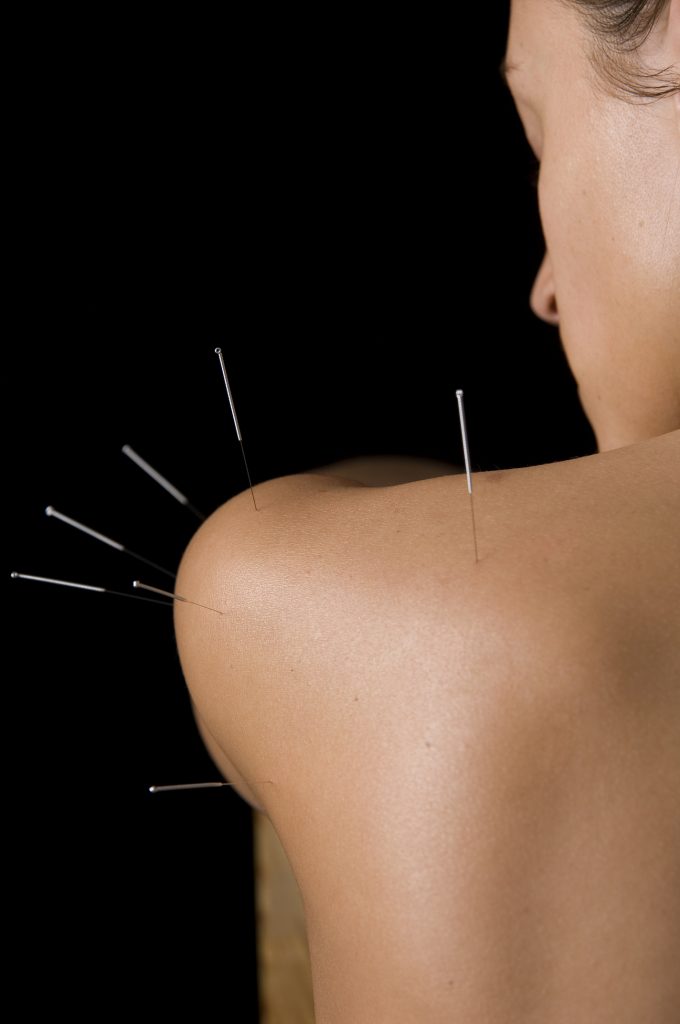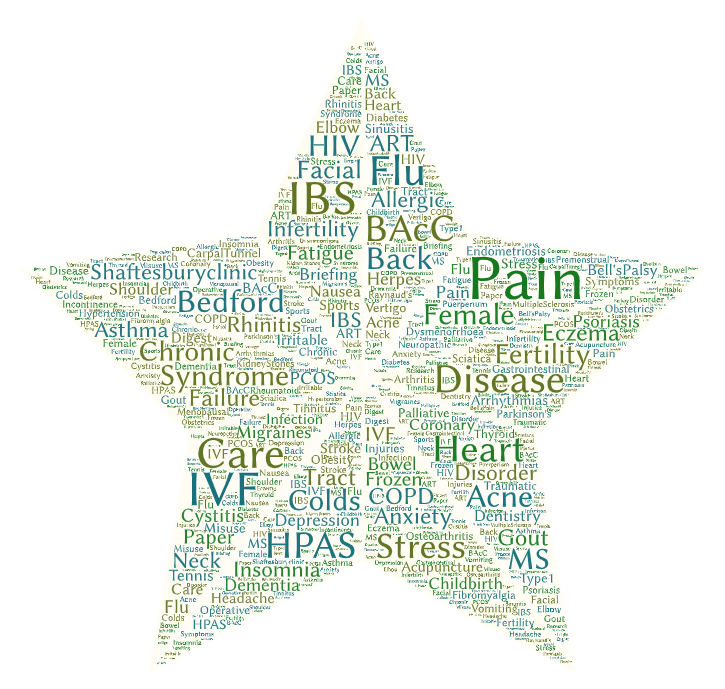Important to know: Chronic health conditions should be addressed under direct medical supervision of your GP or consultant, and acupuncture would be an adjunct or complement to usual care – we advise that you let you doctor know when you use this approach.
Interpreting the research:
When reading health research, it is important to know that Systematic Reviews or Meta Analyses of a large number of high-quality research studies are the very best way to be able to say to what extent a given treatment can address a condition, symptom, or set of symptoms. The next best level of evidence is the individual Randomised Controlled Study (RCT) which uses a systematic technique to compare two or more groups of patients receiving different treatments (or a treatment against a “control”, or no treatment). In acupuncture trials, the nature of the control group is of particular interest as it is hard to blind a patient to whether they are having a needle inserted or not, and even more challenging to blind the researcher/team to this.
The means and quality of how research is carried out varies considerably from country to country, and in terms of how an intervention is compared to another intervention (or a control). Of note is the fact that “sham” acupuncture (where needles are placed in apparently inert locations rather than traditional acupuncture points) is not really an inert process as it has physiological effects, so that comparing sham and “true acupuncture” may therefore not give a clear picture alone; but and form a part of a research body where acupuncture versus no treatment, vs conventional treatment or vs a different approach/modality also form part of the evidence base.
The n= figure (where quoted in research) tells you how many people were participants in the study, and usually the larger a study (when it is of good quality and design), the more likely it is to be reliable and applicable to larger populations. When (statistical) “significance” is discussed in view of studies it has a very particular meaning – it is the confidence in the data (using statistical tests) that tells us how likely a result could have just come about by chance. The lower the possibility of a chance result, the more likely it is due to the intervention in the experiment. When you are reading a trial/study, the “p” is the number telling us of significance, and this must be under 5% (or p less than 0.05) to mean we can say it is a (statistically) “significant” result.
Acupuncture and Fibromyalgia
A systematic review and meta-analysis of randomized controlled trials (Zhang et al, 2019) looked at this area, examining 12 trials comparing acupuncture to sham. The researchers found acupuncture superior to sham for fibromyalgia patients in terms of pain relief and quality of life, with low-to-moderate evidence quality. This is a positive trend warranting further high-quality trials and an indication that acupuncture may be a useful approach for these patients. Acupuncture was also found to be very safe and low in side effects.
Another systematic review and meta-analysis (Kim et al, 2019 : 10 RCT trials; n=690) found acupuncture more effective than sham for short-term pain relief, improving sleep quality, and quality of life in fibromyalgia patients, but were unable to verify effects of fatigue. They also noted that: “evidence quality of moderate level in pain relief made our confidence in the effect estimate limited”, echoing the need for further study in this promising area.
The most recent systematic review and meta analysis (Zheng at al, 2022) looked at 12 studies (n=715), and concluded that for fibromyalgia patients: “Low to moderate quality of evidence suggests that real acupuncture is more effective than control treatment in alleviating pain and improving well-being in both the short- and long-term. Furthermore, we believe that manual acupuncture with at least 10 sessions can achieve better analgesic effect”. They called for future large-scale rigorous studies to corroborate this. They were unable to verify the effect of acupuncture on fatigue, sleep quality, physical function, and stiffness for this patient group.
A small RCT (Mist & Jones, 2018; n=30) randomised female fibromyalgia patients who had moderate to severe pain levels to either acupuncture or group education (no acupuncture). The researchers concluded that group acupuncture improved global symptom impact, pain, and fatigue more than did group education; and was well-tolerated and safe.
An RCT study in 76 fibromyalgia patients (Mawla at al, 2021) looked at outcomes as well as mechanisms of action, using pain scores as well as MRI brain imaging and measures of neurotransmitters in the body. After 8 treatments the acupuncture group had a greater reduction in pain than control, visible difference in the part of the brain related to the somatosensory part of the leg stimulated by acupuncture, and increased GABA (a neurotransmitter – more information in the following section on Pain, below) in the anterior insula of the brain.
A 3-armed Spanish RCT (Garrido-Ardila et al, 2020: n=135) compared acupuncture, physio core stability training and control for women with fibromyalgia. They found comparable improvements in the two intervention groups versus control, such that statistically significant improvements were seen at 6 weeks in both acupuncture and physiotherapy groups vs. the control group on the Berg Balance Scale, 10-m walk test at comfortable speed, and timed up and go test. Their conclusion was “core stability-based physiotherapy and acupuncture improve dynamic balance and postural control in women with Fibromyalgia.”
Di Carlo et al (2020: n=96) demonstrated the short-term efficacy of an eight-week course of acupuncture, (in addition to ongoing drug therapy), in patients with severe fibromyalgia. Of note is that the study did not have a control group, but an area of interest in the way they did this study was to look at features of pain catastrophising and neuropathic issues, which form a part of this disease picture, so future studies should include this but also a control group. A positive effect was found on pain catastrophising, as well as improvement in pain that was of a neuropathic quality.
A Brazilian RCT (Targino et al, 2008) randomized 58 female patients to acupuncture plus tricyclic antidepressants or exercise plus tricyclic antidepressants. After 20 sessions, there was a significant improvement for the acupuncture group in pain measures and the number of tender points; which lasted for 3 months after the end of treatment.
A Spanish RCT in a primary care setting (Vas et al, 2016: n=164), split fibromyalgia patients into individualised acupuncture or sham acupuncture groups; reviewing pain intensity at 10 weeks. The individualised acupuncture group had a marked improvement in painful symptoms, functional capacity and quality of life versus the control, and the effect persisted to 1 year follow up.
A small Turkish study (Yüksel et al, 2019: n=42) looked at the effect of acupuncture and transcutaneous electric nerve stimulation (TENS) on the brain scans of two groups: fibromyalgia patients vs healthy volunteers. Decreased pain and increased inhibitor activity were seen in the TENS and acupuncture groups, both of which were concluded to be beneficial of fibromyalgia patients.
An RCT (Martin et al, 2006) randomized 50 fibromyalgia patients to acupuncture or sham, using measures of Fibromyalgia Impact Questionnaire (FIQ) and the Multidimensional Pain Inventory , and found that acupuncture improved total fibromyalgia symptoms, (vs placebo), and notably fatigue and anxiety were the most improved symptoms. Activity and physical function levels did not change, however.
A recent review of studies from the USA, lead by researchers from Harvard Medical School (Berger et al, 2021), found that whilst more research is needed into acupuncture for fibromyalgia, there was “positive evidence in most studies examining the use of acupuncture as an adjunct to exercise, physical therapy, or pharmacological treatment, and in light of the safety and availability of the treatment, there seems to be increasing evidence supporting the incorporation of acupuncture as part of multi-modality treatment plans for fibromyalgia.” [page 7].
Acupuncture and Pain in general
“Acupuncture has been widely applied to alleviate several pain diseases and incorporated into guidelines, and it is an effective method of coping with the opioid crisis and is widely respected due to its safety, low price, and low addiction” – Zhang et al, 2022
Acupuncture studies have shown it can: provide pain relief by stimulating nerves in body tissues and leading to endorphin release (natural painkilling substances), as well as downregulating the brain and nervous system’s reaction to stress and pain (Zhao 2008; Zijlstra et al, 2003; Pomeranz, 1987).
Acupuncture stimulates the body to create its own natural painkilling substances, such as Beta Endorphins (β-Endorphin). In studies acupuncture has been shown to stimulate the production of natural painkillers called opioid-like peptides (OLPs), including β-Endorphin: For example, this was shown in an RCT in 90 patients with a range of painful disorders (Petti et al, 1998). The same study showed acupuncture also and enhanced the activity of immune cells (lymphocytes, natural killer cells and monocytes) that help fight infections and diseases (Petti et al, 1998).
Acupuncture has been shown in animal models to promote the release of factors that involved in the reduction of inflammation (vascular and immunomodulatory factors – (Kim et al, 2008; Kavoussi and Ross, 2007 [review article]; Zijlstra et al, 2003), and also to affect levels of serotonin (in an animal model), and other peptides in the brain and nervous system and modulate blood flow in the brain and elsewhere in the body, in humans (Zhong and Li, 2007; Shi et al, 2010).
Very specific effects have been seen on a number of neurotransmitters, when acupuncture treatment is given, and to investigate this, a large and growing body of evidence has accumulated from clinical experiments with animal models, where levels of neurotransmitters and their effects are measured objectively; and because the animal is not aware of the intended outcomes, this drastically reduces any influence of placebo effect, as a cause of pain relief.
Human trials, where measurable in an ethical and objective way, are also employed through fMRI (brain scans showing which areas are stimulated or downregulated in acupuncture treatment), measuring blood levels of neurotransmitters as well as pain ratings for an objective approach.
The role of acupuncture in modulating neurotransmitters involved in pain has been well discussed. Zhang et al (2022) outlined the research on each of the main observed neurotransmitter roles that have been researched in acupuncture for pain: those are opioid peptides; γ-Aminobutyric acid (GABA); Norepinephrine; 5-Hydroxytryptamine (5-HT – aka serotonin); and glutamate. Overall for these neurotransmitters (in turn), the following are the highlights from the research body per Zhang and colleagues:
- Endogenous opioid peptides are produced in the body as a direct result of acupuncture, and have a positive effect on analgesia (pain relief). By name, these are enkephalins, endomorphins, dynorphins, and nociceptin, and these are the body’s own natural painkilling substances, types of neurotransmitters, or chemical messengers of the nervous system
- γ-Aminobutyric acid (GABA) is an inhibitory neurotransmitter in the central nervous system. It has a painkilling effect, and it has been demonstrated that acupuncture can upregulate GABA expression; another part of how acupuncture helps with pain
- Norepinephrine (noradrenalin in the UK), is a neurotransmitter, the release of which is enhances by acupuncture; this influences pain because norepinephrine is also capable of inhibiting pain in the body
- 5-Hydroxytryptamine (5-HT), or serotonin; is a neurotransmitter that is involved in analgesia (pain relief). 5-HT is secreted in the brain during acupuncture administration, making it another known mechanism of action for acupuncture’s ability to help pain
- Glutamate is a central nervous system neurotransmitter (chemical messenger), and is involved in the transmission of pain signals in the spinal cord. Acupuncture downregulates glutamate, as part of how it provides pain relief
Zijlstra et al (2003) reviewed the effects and mechanisms of acupuncture in treating various inflammatory diseases and conditions. They proposed the mechanisms of action:
- Acupuncture may release neuropeptides from nerve endings that have vasodilative and anti-inflammatory effects through CGRP.
- Acupuncture may also interact with substance P, which is involved in pain transmission and inflammation.
- Acupuncture may contribute to analgesia by stimulating the release of β-endorphin, which binds to opioid receptors and inhibits pain signals.
- Acupuncture may influence the balance between cell-specific pro-inflammatory and anti-inflammatory cytokines such as TNF-α and IL-10.
Acupuncture can activate mast cells at acupoints, which release histamine, serotonin, adenosine, and other mediators that modulate nerve transmission and inflammation (Li et al, 2022)
Animal Models
Electroacupuncture (EA) has been shown in a rat model (Li et al, 2008) to have anti-inflammatory benefits by modulating the hypothalamic-pituitary-adrenal (HPA) axis, (HPA axis regulates the stress response and immune function). Specifically, Li et al outlined that EA sets off a cascade in the brain (via corticotropin-releasing hormone, and adrenocorticotropic hormone) to produce cortisol, which reduces inflammation and oedema.
Overall, per the research it can be seen that a combination of demonstratable mechanisms is at play; as measured and observed to be the cause of why acupuncture has been shown in so many practical studies to help a number of different types of pain.
Regarding Your Individual Condition and Symptoms:
Whilst the scientific studies are of great interest to researchers and acupuncturists in terms of comparing protocols, for the patient not versed in research they are less accessible, which is why when we asked “can acupuncture work for my (condition or symptom) we are not able to give a simple yes or no response. We are able to tell you what experience we have had in our decades of experience in practise, of the types of outcomes we have seen in similar cases, and give you an idea of our level of experience and knowledge in that area, and how this could relate to your own individual situation. For this, we recommend booking a free telephone consultation where we can answer any questions you have and give a realistic appraisal of what acupuncture may be able to provide.
Also of Interest
See also our blog about a BBC Morning Live feature discussing many aspect of fibromyalgia and complementary approaches, where Dr Punam recommended acupuncture as part of a patient-centred approach.
References:
Berger AA, Liu Y, Nguyen J, et al. Efficacy of acupuncture in the treatment of fibromyalgia. Orthopedic Reviews. 2021;13(1). doi:10.52965/001c.25085Di Carlo, M., Beci, G. and Salaffi, F., 2020. Acupuncture for fibromyalgia: an open-label pragmatic study on effects on disease severity, neuropathic pain features, and pain catastrophizing. Evidence-Based Complementary and Alternative Medicine, 2020.
Garrido-Ardila, Elisa María, María Victoria González-López-Arza, Maria Jiménez-Palomares, Agustín García-Nogales, and Juan Rodríguez-Mansilla. “Effectiveness of acupuncture vs. core stability training in balance and functional capacity of women with fibromyalgia: A randomized controlled trial.” Clinical Rehabilitation 34, no. 5 (2020): 630-645.
Kim, J., Kim, S.R., Lee, H. and Nam, D.H., 2019. Comparing verum and sham acupuncture in fibromyalgia syndrome: a systematic review and meta-analysis. Evidence-Based Complementary and Alternative Medicine, 2019.Pomeranz B. Scientific basis of acupuncture. In: Stux G, Pomeranz B, eds. Acupuncture Textbook and Atlas. Heidelberg: Springer-Verlag; 1987:1-18.
Li, A., Lao, L., Wang, Y., Xin, J., Ren, K., Berman, B.M., Tan, M. and Zhang, R., 2008. Electroacupuncture activates corticotrophin-releasing hormone-containing neurons in the paraventricular nucleus of the hypothalammus to alleviate edema in a rat model of inflammation. BMC Complementary and Alternative Medicine, 8(1), pp.1-8.
Li, Y., Yu, Y., Liu, Y. and Yao, W., 2022. Mast cells and acupuncture analgesia. Cells, 11(5), p.860.
Martin, D.P., Sletten, C.D., Williams, B.A. and Berger, I.H., 2006, June. Improvement in fibromyalgia symptoms with acupuncture: results of a randomized controlled trial. In Mayo Clinic Proceedings (Vol. 81, No. 6, pp. 749-757). Elsevier.
Mawla, Ishtiaq, Eric Ichesco, Helge J. Zöllner, Richard AE Edden, Thomas Chenevert, Henry Buchtel, Meagan D. Bretz et al. “Greater Somatosensory Afference With Acupuncture Increases Primary Somatosensory Connectivity and Alleviates Fibromyalgia Pain via Insular γ‐Aminobutyric Acid: A Randomized Neuroimaging Trial.” Arthritis & Rheumatology 73, no. 7 (2021): 1318-1328.
Mist, S.D. and Jones, K.D., 2018. Randomized controlled trial of acupuncture for women with fibromyalgia: group acupuncture with traditional Chinese medicine diagnosis-based point selection. Pain Medicine, 19(9), pp.1862-1871.
Petti, F.., Bangrazi, A., Liguori, A., Reale, G. and Ippoliti, F., 1998. Effects of acupuncture on immune response related to opioid-like peptides. Journal of Traditional Chinese Medicine 18(1), pp.55-63.
Shi H, Li JH, Ji CF, Shang HY, Qiu EC et al.[Effect of electroacupuncture on cortical spreading depression and plasma CGRP and substance P contents in migraine rats]. Zhen Ci Yan Jiu. 2010 Feb;35(1):17-21.
Targino, R.A., Imamura, M., Kaziyama, H.H., Souza, L.P., Hsing, W.T., Furlan, A.D., Imamura, S.T. and Neto, R.S.A., 2008. A randomized controlled trial of acupuncture added to usual treatment for fibromyalgia. Journal of Rehabilitation Medicine, 40(7), pp.582-588.
Vas, J., Santos-Rey, K., Navarro-Pablo, R., Modesto, M., Aguilar, I., Campos, M.Á., Aguilar-Velasco, J.F., Romero, M., Párraga, P., Hervás, V. and Santamaría, O., 2016. Acupuncture for fibromyalgia in primary care: a randomised controlled trial. Acupuncture in Medicine, 34(4), pp.257-266.
Yüksel, M., Ayaş, Ş., Cabıoğlu, M.T., Yılmaz, D. and Cabıoğlu, C., 2019. Quantitative data for transcutaneous electrical nerve stimulation and acupuncture effectiveness in treatment of fibromyalgia syndrome. Evidence-based complementary and alternative Medicine, 2019.
Zhang, X.C., Chen, H., Xu, W.T., Song, Y.Y., Gu, Y.H. and Ni, G.X., 2019. Acupuncture therapy for fibromyalgia: a systematic review and meta-analysis of randomized controlled trials. Journal of pain research, 12, p.527
Zhang, M., Shi, L., Deng, S., Sang, B., Chen, J., Zhuo, B., Qin, C., Lyu, Y., Liu, C., Zhang, J. and Meng, Z., 2022. Effective oriental magic for analgesia: acupuncture. Evidence-Based Complementary and Alternative Medicine, 2022.
Zhao ZQ. Neural mechanism underlying acupuncture analgesia. Prog Neurobiol. 2008 Aug;85(4):355-75.
Zhong G.-W. Li W. Effects of acupuncture on 5-hydroxytryptamine1F and inducible nitricoxide synthase gene expression in the brain of migraine rats. Journal of Clinical Rehabilitative Tissue Engineering Research. 2007;11(29)(pp 5761-5764)
Zijlstra FJ, van den Berg-de Lange I, Huygen FJ, Klein J. Anti-inflammatory actions of acupuncture. Mediators Inflamm. 2003 Apr;12(2):59-69.
Resources:
British Acupuncture Council evidence based factsheet about Fibromyalgia including specific research, trials and mechanisms of action for acupuncture in this condition.




